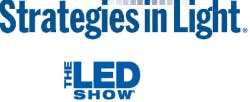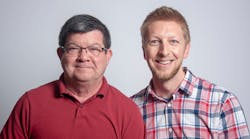BOB STEELE, co-chair of Strategies in Light, interviews Lighting Research Center director MARK REA regarding his views on the subject of “value thinking in lighting” and what attendees can expect from his panel session at SIL 2015.
· Jerry Duffy, general manager, global product management, GE Lighting
· Lori Brock, director of research and innovation, Osram Sylvania
· Karl Geisler, thermal engineer, Advanced Lighting Systems
· Peter Kuehnel, business leader – office, industry and healthcare, Philips Lighting
The panel will discuss the challenges and opportunities for transforming our collective thinking about lighting as a “socket filling” business to one that is a “value providing” business. Solid-state lighting provides the technological potential for this transformation, but that potential will not be fully realized unless there is a robust and comprehensive social change in the way we all think about our business.
Value is defined as providing the greatest benefit at the lowest cost, not simply the greatest lumens for the fewest watts or, more fundamentally, the greatest lumens for the lowest price. As an industry, we understand how to measure watts and price but we have been woefully inadequate at developing metrics to quantify the benefits that lighting actually provides to people. A great deal of research has been conducted over the past century revealing how the human retina converts light into neural signals in the brain. This research can be used to develop powerful benefit metrics for reliably engineering greater safety, security, productivity, health, and wellbeing to the consumers of lighting. Each panel member will provide specific examples of how benefit metrics can be used to increase the value of lighting.
Bob Steele, co-chair of Strategies in Light, recently interviewed Mark Rea regarding his views on the subject of value thinking in lighting and what we can expect from his panel session at SIL 2015.
Bob Steele: Last year at Strategies in Light, you gave a presentation on monetizing the potential benefits of LED lighting. Could you summarize some of the key ideas from that presentation?
Mark Rea: The message is that we have moved out of the 20th century in terms of lighting technologies, but the science has also moved along well enough that we should be able to give better value and benefits to customers in a more quantitative way than we have in the past. Our current value vocabulary is limited to lumens, CRI, watts, and dollars, but there is a gulf between the old benefit metrics and those that the customer cares about today. So if we are able to engineer the better benefits that customers care about, then we should be able to monetize the solid-state lighting systems that we are developing at this time. What I’m afraid of is that if we keep pushing the discussion down to lumens and watts, we really aren’t delivering those better benefits. And I believe that solid-state lighting really does offer the potential of providing advanced benefits, but if we can’t engineer those benefits then that potential will be unrealized and we’re going to fail.An example from another industry goes back to the ‘70s when Ford Motor Company felt that they were being criticized for low-quality cars. They asked customers what they meant by quality and they found that one measure was the sound of the driver door closing. So they got an acoustic signature from a Mercedes closing the door and then engineered that acoustic signature. That was one of their benefit metrics for quality. So, by analogy, the lighting industry needs to begin to quantify the benefits (safety/watt, health/watt, color rendering/watt) that the customer actually cares about and then engineer those benefits. Otherwise, lighting will remain a commodity business.
Steele: What are the key issues that your panel will be addressing at Strategies in Light 2015?
Rea: To answer that, I would like to use what I call legal norms as a rhetorical device. In legal norms you have principles that are not enforceable by law, but you have what the legal profession recognizes as rules, standards, catalogs, and discretion that are enforceable while reflecting those principles. These legal norms range from very strict to quite liberal. So a rule is the strictest legal norm. An example is that to be president of the United States you have to be 35. If you’re 34 you can’t be president, full stop. It’s a pass/fail criterion. In lighting, the Department of Energy has rulemaking that is exactly that, a rule-based norm. They publish lamp efficacy requirements, so a manufacturer either meets it or it doesn’t. Discretion is the most liberal legal norm. I guess in Texas you can be 18 and be a county judge; that’s all it takes. One must assume that these judges can execute proper discretion to determine guilt or innocence. In lighting, the designer has similar latitude. We hope the lighting designer will do the right thing with regard to quality and not just follow prescriptive rules.
The argument I hope to make is that we have to address all four lighting norms. We have to re-examine the rules and the standards we follow based upon evolving social principles. We need to take a fresh look at those evolving characteristics that customers consider to be “good” lighting. This new look includes an examination of credentialing and education as well as rules and standards so that designers can understand the benefits that customers desire.
The argument is that there is no real silver bullet if we want to monetize solid-state lighting. We have to continue do a good job on the technology, but that’s not enough. We need to upgrade our lighting norms, that is, the rules, the standards, the catalogs, and the discretion which reflect the principles of good lighting. I just don’t believe that if we have better technology the world is going to get better. I think there really has to be specific industry focus on new metrics, for our own good and that of society. What I have asked the panel to do is to say whatever they want to say about value and benefit metrics, but my impression from the four people we have on the panel is that they are also uncomfortable with the current lighting reality matrix. How they address this problem will obviously be up to them, but I think what we’re seeing is a broader interest in trying to quantify quality, if you will. And I don’t mean to quantify every aspect of quality, but I think that we must develop new metrics that go beyond lumens and CRI.
Steele: What are some of the metrics that you are proposing to measure the value of LED lighting?
Rea: There are two that come immediately to mind as examples. First, I think that the research clearly indicates that we need to move away from just CRI to engineer good color rendering by illumination. There are a lot of people working on that research and I think that the lighting industry has embraced the need for change. I personally believe we could institutionalize adjunct measures to CRI tomorrow, if we recognized the urgent need for new benefit metrics. The second one that everyone is wrestling with now is circadian light. It’s really the next big design criterion. Lighting has been about visibility for a long time, and now we’re seeing more and more emphasis on circadian light. But what does that mean? How do I quantify circadian light? How much do I need to specify? Here again, I think we could promote a useful benefit metric for circadian light today, but we do not. Why? I hope the panel and the audience can begin to answer that question.
Rea: What I will be trying to do at Strategies in Light is to make a business case for value thinking. I hope to evangelize people to the notion that our businesses will get better if we embrace value thinking based upon new metrics. In the end, we all follow the money. Unless we can make the business case for new metrics, I believe that SSL will just be old lighting with a new technology.
Register now for Strategies in Light and the co-located event The LED Show!
ROBERT STEELE is co-chair of Strategies in Light conferences.








